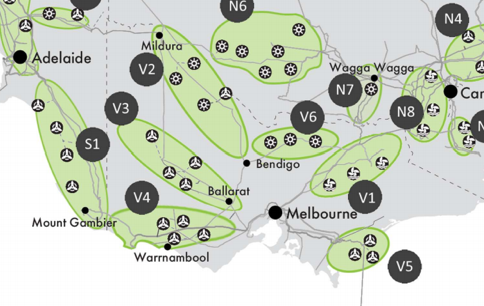In total, the 2020 Victorian budget invests a whopping $1.6 billion for clean energy and energy efficiency. It’s the largest investment of this kind from any state, ever.
We’ve put together this overview to help you understand the detail behind these game-changing announcements.
During our budget night webinar Environment Victoria’s Campaigns Manager, Nicholas Aberle, gave a run-through of the key items in the budget from a climate perspective. We’ve included his presentation here, and some further detail on those and other budget measures below.
Two of the big highlights from the budget were a $797m package for household energy and $540m to establish six new Renewable Energy Zones.
ENERGY EFFICIENCY – $797m
Energy efficiency is a critical climate solution. It also saves people money on their energy bills and creates jobs in a range of trades across the state. It’s a win-win-win.
The package includes:
- $335m to replace 250,000 old heaters with efficient electric alternatives. The old heaters will be mostly gas heaters, with some wood heaters and inefficient electric panels. The shift away from gas appliances is a great step forward: not only does it mean we can avoid damaging new gas supply projects like AGL’s proposed Crib Point import terminal and onshore drilling, but it also means we can fully decarbonise household energy by running electric appliances on renewable energy – either straight from the rooftop or from the grid.
- $112m to provide energy upgrades at 35,000 social housing units. In addition to heating replacements, this will include draught-sealing – a super-effective way to helping people stay warm in their homes in winter.
- $191m to expand the rebate schemes for rooftop solar and household batteries.
- $31m to assist medium and large industrial businesses upgrade to more energy-efficient production lines. More detail here >>
RENEWABLE ENERGY ZONES – $540m
Our old centralised electricity grid was not designed to have large numbers of wind and solar farms distributed around the state. This is a massive problem that is already slowing down renewable energy projects.
So with a commitment of $540m over four years, the Andrews government is aiming to fix this by creating “Renewable Energy Zones”. The zones were identified by the Australian Energy Market Operator (AEMO) and include areas where certain types of renewable energy projects are likely to be built and can capitalise on economies of scale.

The money in this budget is to upgrade the existing grid in those zones to enable significantly more clean energy to get connected and the grid to run smoothly with those higher penetrations of renewables.
Works are likely to include upgrading existing transmission lines to run at higher capacity, short additions to the transmission network, new transformers, and things like “synchronous condensors” which help the grid cope without coal and gas power stations.
The budget also includes:
- $12.6 million for the second reverse auction under the Victorian Renewable Energy Target (VRET). This is expected to bring online more than 600 megawatts of new clean energy.
- A $108 million ‘innovation fund’ to prepare Victoria for ground-breaking projects like renewable hydrogen and Australia’s first offshore wind generator.
- $27 million for local energy projects like microgrids, neighbourhood batteries, and community-owned renewable energy projects.
Other important announcements
Latrobe Valley Authority
The Latrobe Valley Authority has had its funding extended and it remains a stand-alone agency. Along with Regional Development Victoria, there is $125m in funding, but it isn’t clear how much of this goes to the LVA. Also, curiously, the budget seems to only provide for two years of LVA funding – typically budget measures include four years of funding. But we have been told the government remains committed to this work, which is encouraging, because the energy transition will affect the workers and the community of the Latrobe Valley more than most and new economic activity needs to be brought to the region.
4 Million Trees
4 million trees will be planted. There is $92m (over 8 years) to re-forest 6,000 hectares of land. We have been told this will not be massive monocultures, so this program should provide benefits to both carbon sequestration and biodiversity.
Road user charge for electric vehicles
This is the main backwards step in the budget – although it seems this is not actually part of the appropriations bill for this budget, but rather will form part of the state budget next May. In all other respects, the Andrews government has indicated it wants to accelerate the roll-out of electric vehicles, so applying this hand-brake is frustrating. It is worth remembering that Infrastructure Victoria has said that “unless Victorians adopt low or zero emission vehicles at a faster pace than current trends, we will not reach the state’s legislated target of net zero emissions by 2050.”
WHAT’S NEXT?
In this context, two upcoming tests for the Andrews government are:
- Making sure the implementation of these budget measures happens quickly and effectively;
- Putting together the energy transition and other emissions-cutting measures in this budget into an ambitious Climate Change Strategy with strong emissions reduction targets for 2025 and 2030.
The Climate Change Strategy and Emissions Reduction Targets have also been delayed due to COVID-19. The scale of budget measures are a reason to believe that the Andrews government might go big on these critical decisions, but we will have to wait and see when the targets are announced.